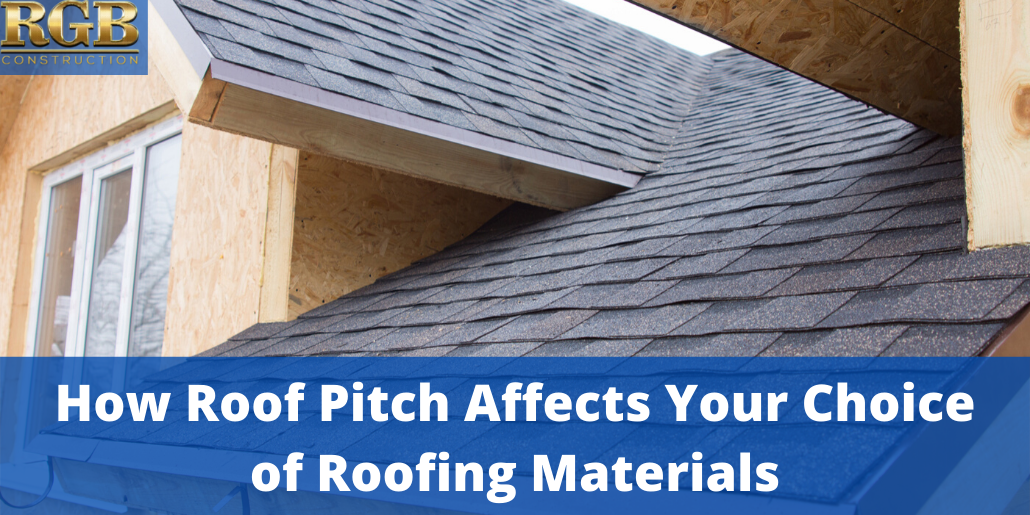Most home and property owners don’t realize that the issues occurring with the roof might be due to the type of roofing material they are using. When deciding if you are going to be using shingles or clay tiles or even BUR, you need to think about the steepness of the roof and the angles. Otherwise, your selection might not protect your roof well at all, and that means you lost out on your investment and time.
Let’s have a closer look at how roof pitch affects your choices in roofing materials:
What Is Roof Pitch?
The pitch of a roof is the angle of the roof, or its slope. Usually, this number is defined by a number, such as 2/12, indicating a ratio. You might also see the same number written with a colon (2:12). Either way it is notated, it means that the roof pitch consists of two measurements:
- Numerator: The first number, referring to the vertical measurement of the roof.
- Denominator: The second number of the ratio, denoting the horizontal (length) of the roof. However, the length is always going to be 12. Just keep in mind that if the ratio is 12:12 or 12/12, you don’t reduce it to 1 when talking about roof pitch.
Calculating Roof Pitch
So, if the pitch of the roof is shown as no more than a ratio rather than actual lengths, how do you figure the actual pitch?
Here are a few examples:
- 4/12: This shows that for every 12 horizontal feet, the roof has a 4 foot vertical change in height.
- 8/12: Every 12 feet of length sees an 8 foot rise in vertical height.
Low and High Pitch
Looking at roof pitch ratios, you might see large variances, such as 0.25:12, or 4/12, or 12/12 and wonder what it means in terms of low and high.
The differences of low and high pitch are:
- Low-pitched roof: This roof appears flat or with a faintly perceptible slope. The pitch might be 0.25/12 or 1/12.
- High-pitched roof: Sharply angled roofing with steep slopes and peaks. You might imagine castle spires or Victorian homes. It is not surprising to since a high-pitched roof with 14:12 or 18:12 measurements.
How Roof Pitch Affects Roofing Material Choices
Now, why do you need to know all of this about roof pitch just to choose the kind of roofing material you need for your home or business? Well, not only does roof pitch affect the aesthetic of your home, it also affects the ceiling and attic spaces. It also limits the kinds of roofing materials you can use.
0.25:12 to 3:12 Roof Pitches
As mentioned earlier, any roof with a pitch that is less than or equal to 3:12 is considered a low-pitched roof. You will find a lot of low pitch construction on urban style homes, contemporary models, and industrial buildings. Flat roofing requires special materials, including:
- Built-up Bitumen: Sometimes called BUR or tar-and-gravel, this consists of alternating layers of reinforced synthetic fabrics and bitumen.
- Torch-down: A single layer that is heat-activated with a torch during installation.
- Rubber membrane: Also known as EPDM, this is a true rubber applied with mechanical anchors or glue.
- Standing seam metal: Made of aluminum or another metal that is joined together at raised seams. These can be slightly steepled (4:12), flat (1:12), or even used with higher pitches (19:12).
As you can see, the first three require a very low-pitched roof, nearly flat, since such materials are resistant to standing water, UV exposure, and other common low-pitch roof issues.
2.5:12 to 19:12 Roof Pitches
For roofs with pitches between 2.5:12 and 19:12, you may want to use clay or cement tiles. These materials can be used on low-pitched to moderate-pitched roofs (2.5:12 to 4:12) if a double underlayment is used. However, you cannot use clay or cement on a roof that has a slope higher than 19:12, since the tiles may rattle or slip off.
4:12 to 20:12 Roof Pitches
Many residential homes fall into this category, usually averaging between 5:12 to 12:12. For this reason, most residential homes also use asphalt shingles. 3-tab shingles or architectural/dimensional shingles are an excellent choice for roofs as low as 4:12 and up to 20:12 pitch. However, after 12:12, architectural shingles are a must. Avoid 3-tab. That said, you can enjoy a wide range of roofing materials. Just note that steeper pitches cannot use heavier shingles, since it could put a strain on the roof.
5:12 to 12:12 Roof Pitches
Wood, slate, asphalt, and clay/cement can all be used. Just note that the lower the pitch, the less chance you have of using wood or slate. Why? Slate and wood shingles do not interlock as neatly as clay/cement and asphalt shingles, leaving spaces for water infiltration. Wood and slate shingles are best for roofs around 10:12 to 12:12.
Conclusion
How does roof pitch affect roofing material selection? We mentioned several effects, such as low-pitched roofs needed membranes designed specifically for flat roofs while steeper roofing can use shingles or tiles or slate. However, the steeper the incline, the more precarious it is to use heavier materials, which is why architectural shingles are best for steeper roofing. Meanwhile, lower slants might not be best for wooden shingles. This is why you need to keep roof pitch in mind! Otherwise, you might choose the wrong material.
Ready to learn more about roofing materials and roofing systems? Check out our other blogs and articles!
Have questions that weren’t answered in this article? Get in touch by filling out the contact form. We’re more than happy to answer your questions or discuss your next roofing project.







